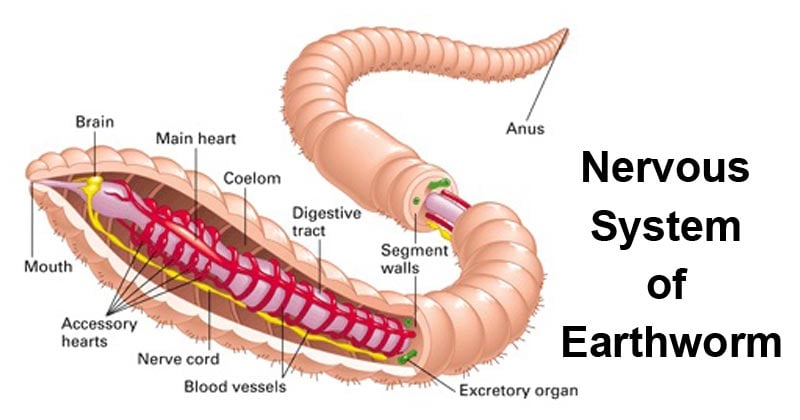- Well developed and concentratednervous system.
- Consists of 3 parts: thecentral, peripheral,andsympatheticnervous system.

Figure: Nervous System of Earthworm. Image Source:Meridian Technical Charter High School.
1. Central nervous system
It comprises of the anteriornerve ringorbrain ringand the posteriorventral nerve cord.
Nerve ring
- Comprises ofcerebral ganglia or supra-pharyngeal ganglia,circumpharyngeal connectives,andsubpharyngeal ganglia.
- A pair of closely united white, pear-shaped,cerebral,orsupra-pharyngeal ganglia, forming the so-calledbrain.
- The brain lies dorsally in 3rdsegment in the groove between the buccal cavity and pharynx.
- From the brain a pair of thick stoutcircumorperi-pharyngealconnectives arise, one on each side, embracing the pharynx and meeting ventrally in4th segment by a pair of fusedsub-pharyngeal ganglia.
- In this way, anerve collaris formed around the pharynx called anerve ringorbrain ring.
Ventral nerve cord
- Originates from the sub-pharyngeal ganglia and runs backward in the mid-ventral line to the posterior end of the body.
- It appears to be single but really is double and made of 2 longitudinal cords fused together in a transverse section.
- In each segment from 5thto the last, it presents a slight enlargement or aganglion.
- Ganglia fused together as swellings representing thesegmental ganglia.
- Histologically, the nerve cord consists ofnerve fibersandnerve cells.
- Externally, nerve cords ofPheretimaare solid an enclosed in a sheath called theperineurium.
- Perineurium consists of 3 layers- the outerperitoneum, middle thin layer oflongitudinal muscle fibers,and inner thick fibrous layer of anepineurium.
- Both nerve cords are separated internally by a vertical epineurium.
- In the region of segmental ganglia,2 cores of nerve fibers are completely fused along the middle line.
- The ventrolateral region of the nerve cord containsbipolarandtripolar nerve cellsall along the length.
- Nerve cells occur more in ganglia.
- Nerve cells and nerve fibers lie embedded in a mass of connective tissues, calledneuroglia.
- Dorsally,4 giant nerve fibers(1 median, 1 submedian, and 2 lateral) runs through the mass of connective tissues along the entire nerve cord.
- These nerve fibers surrounded by epineurium, all are tubular and filled with homogenous plasma-like matter which helps in their contraction.
- These fibers are responsible for the rapid conduction of impulses throughout the nerve cord.
- In the region of segmental ganglia, the partition between the 2 nerve cords are absent.
2. Peripheral nervous system
- 从大脑8到10双神经而产生h supply to the prostomium, buccal cavity, and pharynx.
- 2 pairs of nerves arise from the circumpharyngeal connectives supply 1stsegment and buccal cavity.
- From the sub-pharyngeal ganglia, 3 pairs of the nerve arise supply to 2nd, 3rd,and 4thsegments.
- Each segmental ganglion of the ventral nerve cord gives off 3 pairs of lateral nerves.
- One pair in front and 2 pairs behind the row of setae, they supply the various parts of the segment in which the ganglia are situated.
- 因此,神经来自中央神经us system to supply the different parts of the body constitute the peripheral nervous system.
- Nerve are of mixed type, consists of bothafferentorsensory fibersandefferentormotor fibers.
3. Sympathetic nervous system
- It consists of an extensivenerve plexussituated in the wall of the alimentary canal and some other internal organs.
- Such plexuses are connected with the per-pharyngeal connectives by fine nervules.
- They help in coordinating the functions of the related organs.
Working mechanism of the Nervous System
- All the activities of earthworm are under the control of the nervous system, though not necessarily of the brain.
- Like higher animals, they have bothsensoryandmotor neurons.
- The nerves of the nerve cord have both sensory and motor fibers, i.e., mixed.
- Sensory fibers start from asensory cellorreceptor organsin the epidermis and terminate in the ventral nerve cord in fine branches.
- Near the branches in the cord, and forminga synapsewith them, arise similar branches of motor fibers which run outward and terminate in muscles.
- Stimuliorsensory impulsesare conducted from the receptor by sensory fibers to the ventral nerve cord, from where they are reflected motor impulses along efferent fibers to muscles which contract.
- The circuit of stimuli or impulses forms a simplereflex arc.
- The movement of circular and longitudinal muscles are co-ordinated, so the contraction of one bring about relaxation of the other.
- Giant fibersof the nerve cord conduct impulses more rapidly than other fibers resulting in sudden contraction of the whole body of earthworm when one point is strongly stimulated.
Video: Nervous System of Earthworm & its types By Studio Biology

References
- Kotpal RL. 2017. Modern Text Book of Zoology- Invertebrates. 11th Edition. Rastogi Publications.
- Jordan EL and Verma PS. 2018. Invertebrate Zoology. 14th Edition. S Chand Publishing.

